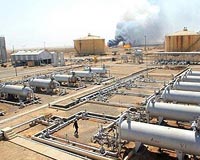 |
New Orleans, Louisiana (AFP) July 15, 2010 British energy giant BP stopped the oil flowing into the Gulf of Mexico on Thursday for the first time in three months as it began key tests hoping to stem the spill for good. Shortly after BP engineers shut down the last of three valves on a giant new cap placed on the blown-out well at around 2:25 pm (1925 GMT), senior vice president Kent Wells announced no oil was leaking into the seas. "I'm very excited to see no oil flowing into the Gulf of Mexico," Wells told reporters, but cautioned it was only the start of a painstaking testing process set to last 48 hours to analyze the condition of the underground wellbore. The announcement was the first sign of real hope for desperate coastal residents who have had their livelihoods ravaged by the worst environmental disaster in the nation's history, now in its 13th week. Teeming fishing grounds have been closed and tourists have been scared away -- two vital economic lifelines for the southern region still struggling to recover from the 2005 Hurricane Katrina. Endangered wildlife has also been increasingly threatened by huge ribbons of oil fouling the shores of five states -- Texas, Louisiana, Mississippi, Alabama and Florida. The costly, massive clean-up is likely to last years. US President Barack Obama, whose administration has led pressure on BP to stop the oil flow, welcomed the news as "a positive sign," but cautioned: "We're still in the testing phase." He said he would address the issue again Friday. BP's chief operating officer Doug Suttles also warned it was not yet time to celebrate, saying more time was needed as the tests are completed. "I think it's an encouraging sign. In a couple of more days it may even be more encouraging, but no celebrations," Suttles told reporters. "If you go talk to these people that live here, celebration is the wrong word." The tests are intended to determine whether the wellbore, which stretches 2.5 miles (four kilometers) below the seabed, was damaged during an April 20 explosion on the BP-leased Deepwater Horizon rig which sank two days later. BP is hoping to choke off the oil flow out of the well, estimated at between 35,000 to 60,000 barrels a day. But cutting off the flow of oil from the top could force oil out in new leaks if the wellbore was damaged. During the test, engineers will take multiple readings from the 30-foot (10-meter) capping stack placed on top of the wellhead on Monday to monitor the pressure inside. High pressure readings would allow the three valves to remain shut and the well would effectively be sealed, but low readings could mean there is a hole somewhere in the casing of the well where oil is escaping. "If we have very low pressure readings, it'd be the equivalent of putting your thumb over the garden hose and the water's going someplace else because there's no pressure," said the official in charge of the US response, Coast Guard Admiral Thad Allen. "If we get high pressure readings, that'd give us some indication that the wellbore's intact, about the integrity of the casing pipe." After 48 hours, the engineers will open up the system again and begin capturing the oil through two surface vessels to allow a new seismic survey to be carried out, Allen said. "That will tell us, as a result of that testing at high pressure for 48 hours, was there a change in the wellbore, did we have oil leak into the formation and form a pocket that could be a precursor for a breach in the ocean floor, is there methane gas coming up, which could be a precursor as well," Allen said. The two oil containment vessels, the Q4000 and the Helix Producer, were shut down before the test started. Obama and his administration are being kept up to date, and Energy Secretary Steven Chu, a Nobel Prize-winning physicist, is involved in the consultations every six hours during the integrity test, alongside BP and government scientists. The Gulf disaster has so far cost BP some 3.5 billion dollars (2.78 billion euros) and compensation claims from devastated residents of the region could reach 10 times that. A final solution to the leak is not expected before mid-August, when crews will complete the first of two relief wells, allowing the oil reservoir to be permanently plugged in a "kill" operation.
Share This Article With Planet Earth
Related Links Powering The World in the 21st Century at Energy-Daily.com
 Iraq's oil boom could tempt Iran
Iraq's oil boom could tempt IranBaghdad (UPI) Jul 15, 2010 Iraq's headlong drive to become the world's top oil producer is gathering pace although building the infrastructure to make that happen poses problems. But there are also political pitfalls: Iraq's energy boom makes a tempting target for Iran as it battles a salvo of sanctions imposed by the United Nations, the United States and the European Union in recent weeks with the aim of throttl ... read more |
|
| The content herein, unless otherwise known to be public domain, are Copyright 1995-2010 - SpaceDaily. AFP and UPI Wire Stories are copyright Agence France-Presse and United Press International. ESA Portal Reports are copyright European Space Agency. All NASA sourced material is public domain. Additional copyrights may apply in whole or part to other bona fide parties. Advertising does not imply endorsement,agreement or approval of any opinions, statements or information provided by SpaceDaily on any Web page published or hosted by SpaceDaily. Privacy Statement |